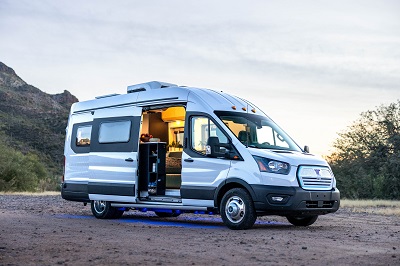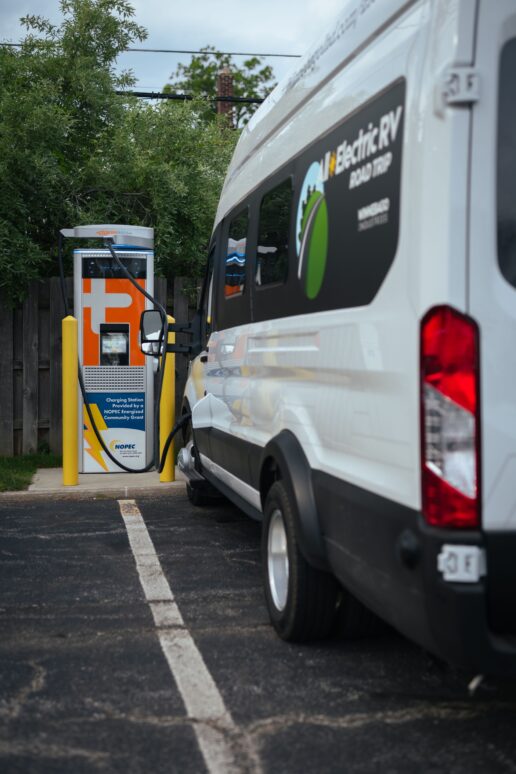
Winnebago Industries recently embarked on an All-Electric RV Road Trip for 1,300 miles in the company’s e-RV concept vehicle from Washington, D.C. to Eden Prarie Minnesota. In part one of this article, RV News reported on the journey travelers, metrics and weigh-stations.
Today, RV News will tour the Type B e-RV, built on a Ford Transit chassis, and discuss additional initial findings the Winnebago Advanced Technology Group (ATG) made on the road.
What’s inside?
When the Winnebago ATG designed its all-electric zero-emission e-RV, the company knew it needed to think differently and “redesign an RV for the electrical vehicle age,” said Ashis Bhattacharya, Winnebago Industries senior vice president, Business Development, Advanced Technology and Enterprise Marketing.
Winnebago had the vehicle modified with an electrical power system from Lightning eMotors to power the drivetrain, vehicle controls and living quarters.
Based in Loveland, Colorado, Lightning eMotors also provides powertrains for Forest River’s bus division and inked a deal earlier this year to repower Forest River gas-powered shuttle buses and passenger vans.
The Winnebago ATG installed two “massive” 86.0 kWh batteries to power the appliances and provide vehicle traction, Bhattacharya said. To make the design more efficient and take full advantage of the 350-volt DC power produced by the batteries, the team installed a more powerful water heater and a roof-mounted air conditioner with a heat pump.
The induction cooktop and refrigerator were designed to run on either 110-volt AC or 123-volt DC power.
The team installed an integrated control system to optimize load and efficiency. System information and controls are shown on a digital display or can be monitored through a tablet or smartphone app.
The vehicle includes wireless connectivity, provided by a residential-grade WiFi network via a dual-modem router.
Galley features include a marine-grade refrigerator, induction cooktop, and matte black sink fixtures. The bathroom incorporates a toilet and a detachable, handheld shower head.
Eco-friendly and sustainable material options were chosen for the coach interior, Winnebago said. The floor is made from recycled cork-rubber flooring. Woolen wall coverings provide thermal and wall insulation.
What did the team learn?
Several ATG team members took the e-RV helm. As they drove, they collected data about the journey to help Winnebago improve e-RV future iterations.
The team is still compiling data it will release at a later date, Bhattacharya said. However, the company is ready to share a few initial findings.
As the team was showing the vehicle at Move America week, the air conditioner ran full blast for eight or nine hours straight. According to Bhattacharya, the RV was very silent and running it ate up very little of the stored battery power. In addition, there were no tailpipe emissions and no exhaust fumes coming into the coach.
The team discovered a longer trip in the e-RV was not only possible, but smooth and easy, Bhattacharya said. The motorhome has pretty good pick-up, he added.
Traveling in the current e-RV works for RVers without a pressing schedule, he said.

“If you have to get a long distance in a hurry, which is, I have to get to Chicago right now from Minnesota and I have to drive 500 miles non-stop, then this RV is not for you,” Bhattacharya said. However, outings such as short trips to nearby parks for camping are possible.
Winnebago said consumers are just learning about electric vehicle technology and education is still needed.
“A lot of people have not driven EVs and that whole education experience piece is important for them to understand, and then they will be more comfortable,” Bhattacharya said.
The Winnebago motorhome team is working to develop the first generation of limited production vehicles for next year, so Winnebago’s focus is to apply insights from the trip and ensure sure the team can build out the best possible vehicles for customers next year, Bhattacharya said.
“One of the numbers I keep reminding people about is 180 feet,” he said. “Why 180 feet? That was the distance of the first Wright Brothers flight 100 years back. Today, we get into planes and casually fly to Europe and think nothing of it. Similarly here: We are at the start of this transition and electrification is a trend that is here to stay.”




